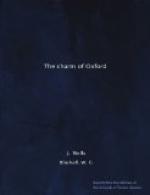[Plate XX. Christ Church: “Tom” Tower]
A patriotic tradition claims for Tom the honour of having inspired Milton’s lines in “Il Penseroso”:
“Hear the far-off curfew
sound
Over some wide-watered,
shore,
Swinging slow with sullen
roar.”
But it is difficult to believe this; Milton’s connection with Oxford does not get nearer than Forest Hill, and blow the west wind as hard as it would, it could scarcely make Tom’s voice reach so far. And the “wide-watered shore” is only appropriate to Oxford in flood time, the very last season when a poet would wish to remember it.
The view in Plate XX of the tower is taken from the front of Pembroke, and must have been often admired by Oxford’s devoted son, Samuel Johnson, when, as a poor scholar of Pembroke, “he was generally to be seen (says his friend. Bishop Percy) lounging at the college gate, with a circle of young students round him, whom he was entertaining with his wit and keeping from their studies.”
ST. JOHN’S COLLEGE
[Plate XXI. St. John’s College : Garden Front]
“An English home—gray
twilight poured
On dewy pastures, dewy trees,
Softer than sleep, all things in order stored,
The haunt of ancient Peace.”
TENNYSON, Palace of Art.
St. John’s shares with Trinity and Hertford the distinction of having been twice founded. As the Cistercian College of St. Bernard, it owed its origin to Archbishop Chichele, the founder of All Souls’, and it continued to exist for a century as a monastic institution. At the Reformation it was swept away with other monastic foundations by the greed of Henry VIII, but it was almost immediately refounded, in the reign of Mary, by Sir Thomas White, one of the greatest of London’s Lord Mayors. In all these respects it has an exact parallel in Trinity, which had existed as a Benedictine foundation, being then called “Durham College,” and which was refounded, in the same dark period of English History, by another eminent Londoner, Sir Thomas Pope. It is characteristic of England and of the English Reformation that men, who were undoubtedly in sympathy with the old form of the Faith, yet gave their wealth and their labours to found institutions which were to serve English religion and English learning under the new order of things.
For the first generation after the Founder, St. John’s was torn by the quarrels between those who wished to undo the work of the Reformation altogether, and those who wished to carry it further and to destroy the continuity of English Church tradition. The final triumph of the Anglican “Via Media” was the work, above all others, of William Laud, who came up as scholar to St. John’s in 1590, and who, for most of the half century that followed, was the predominant influence in the life of the University. First in his own college and then in Oxford generally,




